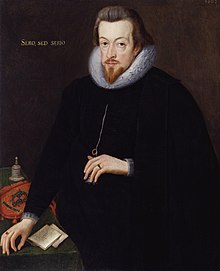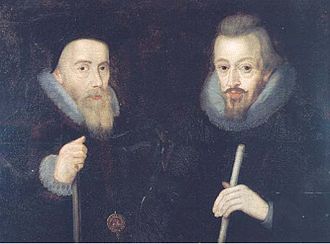Robert Cecil, 1st Earl of Salisbury
Robert Cecil, 1st Earl of Salisbury KG (* 1. June 1563 in Westminster , London ; † 24. May 1612 in Marlborough , Wiltshire ) was an English statesman and Minister of Elizabeth I and James I .
Childhood and youth
Robert Cecil was born the second son of William Cecil, 1st Baron Burghley and Mildred Cooke, a daughter of Sir Anthony Cookes (1505–1576). He suffered from mild physical deformities, a misalignment of his legs and a humpback.
His father William Cecil, Lord Burghley, who was Minister, Chancellor of the Exchequer and most important advisor to Elizabeth I, had him prepared from an early age for the future position of Minister of the Queen. Cecil's early upbringing first came from his mother, one of the most educated women of her time, and later from tutors. The family's house on the Strand in London was a meeting place for high society, at the Theobald's country estate, which Lord Burghley had built in Hertfordshire from 1563, Cecil met Queen Elizabeth as a child. In 1577 Robert Devereux , the young 2nd Earl of Essex, lived in the Cecil household for at least 10 weeks.
In 1580, like his father, Robert Cecil was accepted into Gray's Inn , where he attended law lectures. From July 1581 he attended courses in Cambridge, 1582 he was taught privately again. In 1583/84 he visited Paris, where he also took part in Sorbonne events. On his return in 1584 he was elected to Parliament for the City of Westminster , and in 1586 he was re-elected.
Political career
In 1586, Elizabeth I was under heavy pressure to have the Scottish Queen Mary Stuart executed for her involvement in the Babington conspiracy . Shortly after Elizabeth gave an address to both Houses of Parliament in which she said she would “pray for a solution”, a tract appeared entitled The Copie of a Letter to the Right Honorable the Earle of Leycester . Allegedly written to inform Robert Dudley , the Earl of Leicester, of the events in England after his stay in the Netherlands, it was supposed to show that Elizabeth did not make the decision about the execution easy. It contained the Queen's speech and the petitions that had been tabled in Parliament, along with a preface signed with the initials RC. What looked like a gallant act by the young Cecil was actually well-planned political propaganda - his father Lord Burghley, Elizabeth's minister and secret service chief Francis Walsingham , and the Queen herself had worked out the treatise with Cecil.
After Walsingham's death in April 1590, Burghley officially took over his functions as principal secretary of state , but much of the work was already done in the background by his son. In 1591 the Queen appointed Cecil, who was only 28 years old, to be a member of the Privy Council (he was to remain the youngest member ever accepted). Although Cecil held the de facto office of principal secretary , Elisabeth shied away from officially appointing him, also because she shied away from a confrontation with her ambitious favorite Robert Devereux , the Earl of Essex.
Cecil and Essex
In the early 1590s, England and her government faced significant political pressure and a variety of crises, including sporadic sea wars with Spain, war in Ireland and a series of devastating crop failures. In the same period between 1588 and 1591 both the deaths of important key political figures such as Robert Dudley, Walter Midmay and Christopher Hatton and the subsequent rise of Cecil's main opponent Robert Devereux, the 2nd Earl of Essex, led to increasing internal clashes in the government led.
While Essex was on an expedition to conquer Cádiz , the Queen appointed Cecil on July 5, 1596, as secretary of state . In March of the following year Essex was appointed Master-General of the Ordnance , making him in charge of British artillery, all fortifications and military supplies.
Even after the death of Cecil's father in 1598, further conflicts developed, for example the rivalry between Essex and Cecil for the influential post of Master of the Court of Wards , which Cecil won during another absence from Devereux - the Earl of Essex ordered to head an army of 16,000 men to Ireland to put down the rebellion of the Earl of Tyrone . His illegal return in 1599 after only six months in Ireland, combined with an armistice forced by the enemy, gave Cecil the political advantage he needed. Essex fell out of favor with the Queen and was placed under house arrest on October 1, 1599.
On February 8, 1601, Essex, along with two to three hundred other nobles, tried to bring about an uprising among the people of London in support of it. Essex was arrested and detained in the Tower . On February 19, the trial of Essex for high treason took place in Westminster Hall in which he attempted to portray Cecil as a supporter of the succession to the throne of the (Catholic) Spanish heir to the throne Isabella Clara Eugenia , but himself as an advocate of religious tolerance in Elizabeth's sense. Cecil, who was hiding behind a wall curtain, cut off the testimony and requested that Essex cite witnesses to his allegation. His uncle, Sir William Knollys, whom Essex had named as the source, was brought into the room but relieved Cecil entirely. Essex was then sentenced to death and executed on February 25, 1601.
The succession to the throne of Jacob I.

The downfall of his rival Essex made it possible for Cecil to enter into secret correspondence with James VI. of Scotland and to prepare a peaceful transition of the English crown after Elizabeth's death. When the Scottish king finally ascended the English throne as James I in 1603, he expressed his gratitude to Robert Cecil by making him Baron Cecil , of Essendon in the County of Rutland , and in 1604 the title of Viscount Cranborne , in the County of Dorset, and in 1605 that of the Earl of Salisbury .
In contrast to the king, whose main aim was to unite his two kingdoms, England and Scotland, which Parliament rejected in 1607, Cecil saw his priority in a reorganization of state finances. The peace with Spain negotiated under his leadership ( Peace of London 1604) was an important step in the consolidation of the royal budget, trade on the route to the Mediterranean flourished again, and income from customs duties rose.
The Gunpowder Plot
Already in 1603 there were conspiracies of the English Catholics against James I with the Bye Plot and the Main Plot . Their primary goal was the removal of James I and the elevation of Lady Arabella Stuart to the throne. In 1605, Guy Fawkes and his co-conspirators had planned an assassination attempt in which the parliament building was to be blown up on November 5, 1605 during the opening of parliament by the king. On this occasion not only all parliamentarians, but also the entire royal family were present and would have been wiped out in one fell swoop. Around 2.5 tons of gunpowder were deposited in the cellars of the Palace of Westminster for the detonation (hence the English name Gunpowder Plot ("gunpowder conspiracy") for the attack). The conspirators wanted to get Jacob's daughter Elisabeth Stuart installed as the Catholic head of state.
Finances
When Cecil became Lord Treasurer in 1608 and sought extra-parliamentary funding, his ideas for funding the massive increases in spending (as a result of the war in Ireland) that had brought the country to the brink of national bankruptcy were negatively impacted. In 1610 Cecil did not succeed in obtaining parliamentary approval and approval for the Great Contract , his visionary concept for the fundamental reorganization of state finances ( the exchanging of feudal fiscal rights of wardship and purveyance for a regular land tax income - abolition of some feudal rights in exchange for an annual payment to the King approved by Parliament). While his supporters praised his dedication and tireless efforts to contain the inflated budget deficit, he was no longer able to shake off allegations of duplicity and corruption. He had accumulated a considerable amount of private fortune, which was evident in the construction of his country estate, Hatfield House, which he had acquired from James I in exchange for the former country home of the Cecils, Theobalds. At the same time, there were sharp attacks over his own tax payments, which were ridiculously low compared to the average citizen.
Contemporaries linked his physical deformities with his political and moral decline. Towards the end of 1611, his physical condition deteriorated rapidly, probably due to cancer. He died on May 24 of the following year in St. Margaret's Convent. His grave is in Hatfield House Church .
Robert Cecil was married to Elizabeth Brooke (1562–1596 / 7), daughter of William Brooke , Lord Warden of the Cinque Ports under Elizabeth I. They had three children together, Frances (1593–1644), Catherine and William (1591–1668) .
literature
- Salisbury, Robert Cecil, 1st earl of ; Essex, Robert Devereux, 2nd earl of, Viscount Hereford, Lord Ferrers, Lord Bourchier . In: Encyclopædia Britannica 2007 Ultimate Reference Suite . Encyclopædia Britannica, Chicago 2007.
- Pauline Croft: Cecil, Robert, first earl of Salisbury (1563-1612) . In: Oxford Dictionary of National Biography . Oxford University Press, Oxford 2004 ( online ).
Web links
- Robert Cecil, 1st earl of Salisbury at Encyclopædia Britannica Online
- Robert Cecil, 1st Earl of Salisbury on thepeerage.com
Individual evidence
- ↑ Illustration of the grave site ( memento from August 24, 2017 in the Internet Archive )
| predecessor | Office | successor |
|---|---|---|
| New title created |
Baron Cecil 1603-1612 |
William Cecil |
| New title created |
Viscount Cranborne 1604-1612 |
William Cecil |
| New title created |
Earl of Salisbury 1605-1612 |
William Cecil |
| Henry Howard, 1st Earl of Northampton |
Lord of Mann 1607-1609 |
William Stanley |
| personal data | |
|---|---|
| SURNAME | Cecil, Robert, 1st Earl of Salisbury |
| ALTERNATIVE NAMES | Cecil, Robert |
| BRIEF DESCRIPTION | English statesman |
| DATE OF BIRTH | June 1, 1563 |
| PLACE OF BIRTH | Westminster |
| DATE OF DEATH | May 24, 1612 |
| Place of death | Marlborough |
